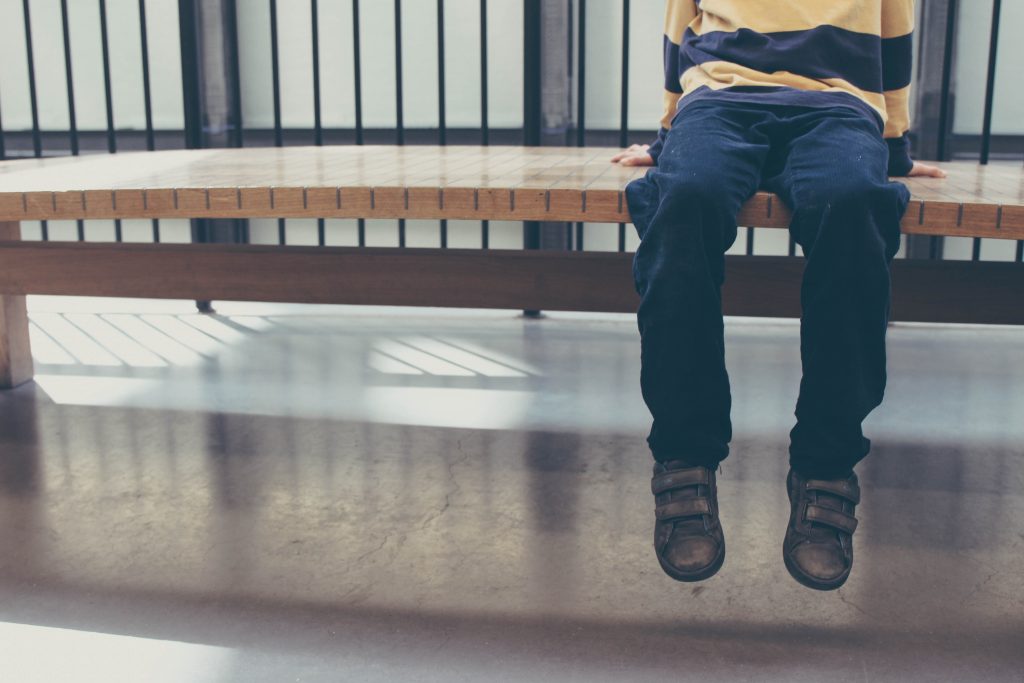
This post is sponsored by Children’s Hospital of Orange County
Rates of anxiety and depression in children have increased in the last decade. This is a topic close to my heart, since I suffered from generalized anxiety disorder as a child. I had the chance to interview Dr. Micaela Thordarson, a child psychologist at CHOC Children’s, to review some of the warning signs and treatment options that parents should be aware of when it comes to kids and anxiety.
 What are the symptoms of anxiety in children?
What are the symptoms of anxiety in children?
Kids who suffer from anxiety can often experience overwhelming worry and anxious thoughts, but Dr. Thordarson emphasizes that this is not the only symptom. In fact, some symptoms may not look like anxiety at all. “Some kids might show irritability or avoidance. They may refuse to do things, or complain about doing things. They may be easily frustrated,” she said. Dr. Thordarson explained that perfectionism and a fear of being judged negatively are common traits for anxious kids, so they can either give up easily or procrastinate because they are so concerned with failure. They may be so terrified of failure that they won’t even try something new.
Kids with anxiety can also display restlessness, fidgeting, difficulty paying attention, and difficulty falling asleep. “For some kids, anxiety can show up as frequent stomachaches or headaches not otherwise explained by a medical condition,” she said. Children who complain of frequent ailments or who seem to obsess about their own health might be suffering from anxiety. She warns that when kids stay home from school due to physical manifestations of anxiety, it can strengthen the response pattern. “If in doubt, send them to school,” she said. Parents need to communicate with their child’s school nurse if they have concerns that anxiety is presenting itself as physical ailments.”
How do we get kids to communicate anxious thoughts?
When kids experience anxiety, we want to help them process things verbally. Oftentimes, kids avoid their anxious feelings, which can lead to some of the symptoms of stomachaches or irritability. We want to shift to helping them talk about it. “Ask your child to share about feelings and then provide immediate praise when they are willing,” Dr. Thordarson advises. “Stay away from reassurance. Don’t say ‘you are going to be ok’ because it takes that child’s safety and places it in your authority. Doing so can also make them feel dismissed, or that they cannot trust you to hear them. Rather, ask them questions as a coach.” Dr. Thordarson recommends asking questions like “How do you know this outcome will come true?” or “What are other ways this can come in?” Reality testing with our kids can be beneficial. We can walk them through scenarios that are playing out in their mind and help coach them to favorable outcomes.
What is the difference between a child who worries a lot, or a child who is just shy, and a child with generalized anxiety disorder?
If there is no change in external circumstances, behavior or performance, but if a child is in a lot of distress, they may be suffering from anxiety. “If a child seems to be upset, anxious or crying more often than not, if they are they taking longer to get things done, if their grades are changing, if they are avoiding friends, if they are in nurses office . . . these would all be signs that getting help is needed.”
In terms of differentiating shy children from social anxiety Dr. Thordarson suggests parents look at the degree of their child’s refusal to engage. “Shy kids might warm up eventually. If they maintain anxiety the entire time, it might be a sign.” She also warns that social anxiety may look like a heavy reliance on social media for social interactions, because it’s safer to interact behind a screen, if a kid does not have the social skills or confidence for face-to-face interactions.
How can social media impact anxiety?
Dr. Thordarson believes that the social skills used on social media or on video games are VERY different than real life. “It’s developing a very small toolkit and letting everything else stay underdeveloped. If something doesn’t go well on social media, the child loses their entire community. They don’t have a social backup plan.” She also thinks that kids who are trying to avoid homework or chores or interacting with parents are going to dive into these realms of alternate reality, which can be a sign of avoidance behaviors. “It’s an escape that is comfortable, where kids don’t have to face their fears or anxieties. It sets up a system of reward in the brain.”
She asserts that setting limits is an extremely important aspect of parenting. “There should be limits on every type of screen source and there should be periods of forced unplugged time, even through high school. There should be limits like no phones at the dinner table, or no phones in the bedroom. When you are glued to your cellphone and constantly getting notifications, you always know when you are left out, and it reinforces the idea that you have to be connected and available all of the time.”
If a parent is concerned about their child’s anxiety, who should they reach out to?
“There is never a harm in having an evaluation,” says Dr. Thordarson. “You can start with your pediatrician. They are likely getting lots of consultations so most have a referral list.” The American Academy of Pediatrics has been making a push to train pediatricians in conducting the conversation on mental health. She says the OC chapter especially has been working on stocking members with toolkits and referral lists. Schools can be another resource. “Schools might have onsite resources, including counselors, which could be good if your child’s anxiety is school-related. Parents can also call the number on the back of their insurance card to find additional resources available to them.”
Dr. Thordarson also suggests that there are some good books that parents can look at. She recommends Dawn Huebner’s What To Do When You Worry Too Much, which teaches tools and strategies so a child’s worries don’t grow out of control. For parents, she recommends Tamar Chansky’s Freeing Your Child from Anxiety.
What is the difference between a counselor and psychiatrist?
It can be hard for parents to know what kind of support their child needs. A psychiatrist is most often a medication manager. “It is unusual for a psychiatrist to offer therapy,” says Dr. Thordarson. “They are generally looking at treating mental health from a medication standpoint.” Most other mental health clinicians (licensed marriage and family therapist or LMFT, social worker, psychologist) are licensed and provide psychotherapy, which will help with coping skills and anxiety reduction. “For mild to moderate anxiety, the most effective therapy, even over medications, is cognitive behavior therapy, or CBT. This short-term, goal-oriented therapy takes a practical approach to changing patterns in your child’s thought process and increasing coping skills, and thus changes the way they feel. ”
How do we model healthy ways of dealing with anxiety to our kids?
Parents should talk about their own worries out loud and how you address them, Dr. Thordarson says. “Walk your kids through your own process. For example, ‘I was nervous to go to work today because of my big meeting. What I did was, I went any way and I told myself that I would be ok.’ Narrate your internal coping process out loud. Join them, and help them cope.
Photo by Michał Parzuchowski on Unsplash

